口译笔记的七个原则
- 格式:doc
- 大小:69.00 KB
- 文档页数:7
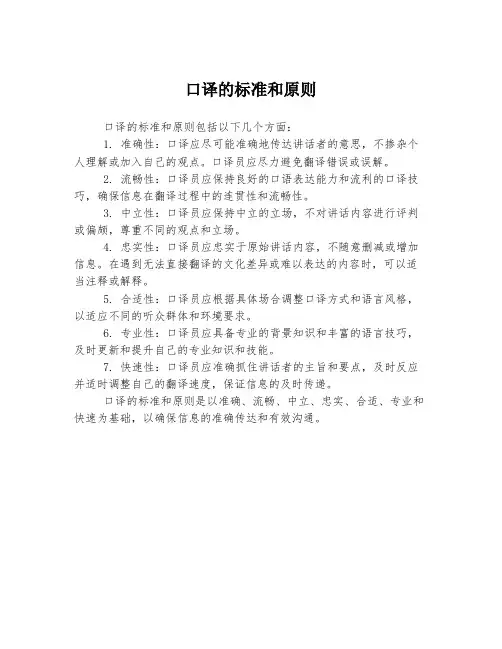
口译的标准和原则
口译的标准和原则包括以下几个方面:
1. 准确性:口译应尽可能准确地传达讲话者的意思,不掺杂个人理解或加入自己的观点。
口译员应尽力避免翻译错误或误解。
2. 流畅性:口译员应保持良好的口语表达能力和流利的口译技巧,确保信息在翻译过程中的连贯性和流畅性。
3. 中立性:口译员应保持中立的立场,不对讲话内容进行评判或偏颇,尊重不同的观点和立场。
4. 忠实性:口译员应忠实于原始讲话内容,不随意删减或增加信息。
在遇到无法直接翻译的文化差异或难以表达的内容时,可以适当注释或解释。
5. 合适性:口译员应根据具体场合调整口译方式和语言风格,以适应不同的听众群体和环境要求。
6. 专业性:口译员应具备专业的背景知识和丰富的语言技巧,及时更新和提升自己的专业知识和技能。
7. 快速性:口译员应准确抓住讲话者的主旨和要点,及时反应并适时调整自己的翻译速度,保证信息的及时传递。
口译的标准和原则是以准确、流畅、中立、忠实、合适、专业和快速为基础,以确保信息的准确传达和有效沟通。
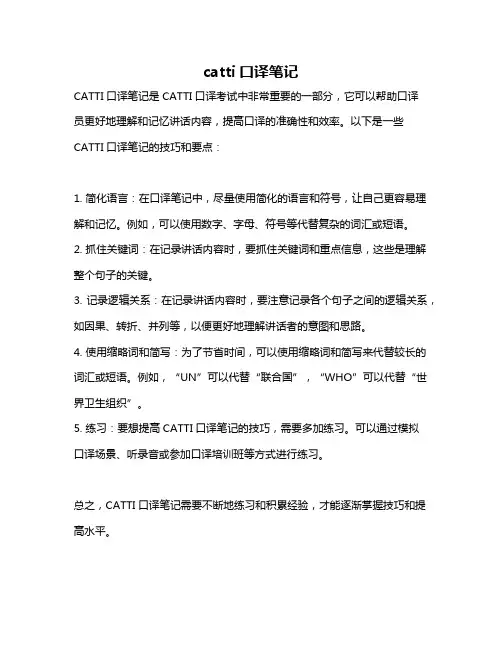
catti口译笔记
CATTI口译笔记是CATTI口译考试中非常重要的一部分,它可以帮助口译
员更好地理解和记忆讲话内容,提高口译的准确性和效率。
以下是一些CATTI口译笔记的技巧和要点:
1. 简化语言:在口译笔记中,尽量使用简化的语言和符号,让自己更容易理解和记忆。
例如,可以使用数字、字母、符号等代替复杂的词汇或短语。
2. 抓住关键词:在记录讲话内容时,要抓住关键词和重点信息,这些是理解整个句子的关键。
3. 记录逻辑关系:在记录讲话内容时,要注意记录各个句子之间的逻辑关系,如因果、转折、并列等,以便更好地理解讲话者的意图和思路。
4. 使用缩略词和简写:为了节省时间,可以使用缩略词和简写来代替较长的词汇或短语。
例如,“UN”可以代替“联合国”,“WHO”可以代替“世界卫生组织”。
5. 练习:要想提高CATTI口译笔记的技巧,需要多加练习。
可以通过模拟
口译场景、听录音或参加口译培训班等方式进行练习。
总之,CATTI口译笔记需要不断地练习和积累经验,才能逐渐掌握技巧和提高水平。
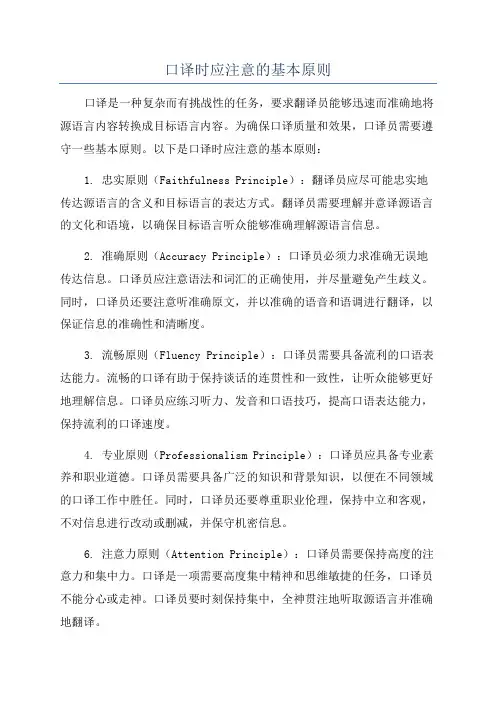
口译时应注意的基本原则口译是一种复杂而有挑战性的任务,要求翻译员能够迅速而准确地将源语言内容转换成目标语言内容。
为确保口译质量和效果,口译员需要遵守一些基本原则。
以下是口译时应注意的基本原则:1. 忠实原则(Faithfulness Principle):翻译员应尽可能忠实地传达源语言的含义和目标语言的表达方式。
翻译员需要理解并意译源语言的文化和语境,以确保目标语言听众能够准确理解源语言信息。
2. 准确原则(Accuracy Principle):口译员必须力求准确无误地传达信息。
口译员应注意语法和词汇的正确使用,并尽量避免产生歧义。
同时,口译员还要注意听准确原文,并以准确的语音和语调进行翻译,以保证信息的准确性和清晰度。
3. 流畅原则(Fluency Principle):口译员需要具备流利的口语表达能力。
流畅的口译有助于保持谈话的连贯性和一致性,让听众能够更好地理解信息。
口译员应练习听力、发音和口语技巧,提高口语表达能力,保持流利的口译速度。
4. 专业原则(Professionalism Principle):口译员应具备专业素养和职业道德。
口译员需要具备广泛的知识和背景知识,以便在不同领域的口译工作中胜任。
同时,口译员还要尊重职业伦理,保持中立和客观,不对信息进行改动或删减,并保守机密信息。
6. 注意力原则(Attention Principle):口译员需要保持高度的注意力和集中力。
口译是一项需要高度集中精神和思维敏捷的任务,口译员不能分心或走神。
口译员要时刻保持集中,全神贯注地听取源语言并准确地翻译。
7. 逻辑原则(Logic Principle):口译员需要善于分析和理解语言信息的逻辑结构和思维方式。
口译员要能够捕捉信息的主旨和重点,并以逻辑清晰的方式进行翻译。
口译员需要灵活运用语言和逻辑推理能力,以便准确传达复杂的语义和论述。
为了更好地遵循这些基本原则,口译员需要不断学习和提高自己的口译技巧。
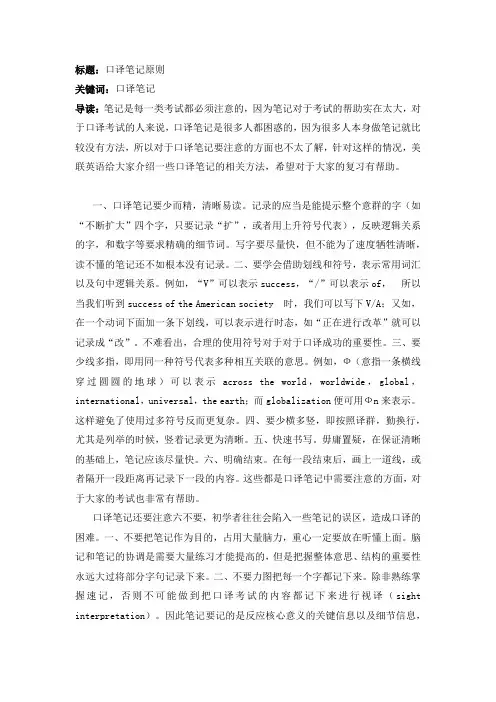
标题:口译笔记原则关键词:口译笔记导读:笔记是每一类考试都必须注意的,因为笔记对于考试的帮助实在太大,对于口译考试的人来说,口译笔记是很多人都困惑的,因为很多人本身做笔记就比较没有方法,所以对于口译笔记要注意的方面也不太了解,针对这样的情况,美联英语给大家介绍一些口译笔记的相关方法,希望对于大家的复习有帮助。
一、口译笔记要少而精,清晰易读。
记录的应当是能提示整个意群的字(如“不断扩大”四个字,只要记录“扩”,或者用上升符号代表),反映逻辑关系的字,和数字等要求精确的细节词。
写字要尽量快,但不能为了速度牺牲清晰,读不懂的笔记还不如根本没有记录。
二、要学会借助划线和符号,表示常用词汇以及句中逻辑关系。
例如,“V”可以表示success,“/”可以表示of,所以当我们听到success of the American society 时,我们可以写下V/A;又如,在一个动词下面加一条下划线,可以表示进行时态,如“正在进行改革”就可以记录成“改”。
不难看出,合理的使用符号对于对于口译成功的重要性。
三、要少线多指,即用同一种符号代表多种相互关联的意思。
例如,Ф(意指一条横线穿过圆圆的地球)可以表示across the world,worldwide,global,international,universal,the earth;而globalization便可用Фn来表示。
这样避免了使用过多符号反而更复杂。
四、要少横多竖,即按照译群,勤换行,尤其是列举的时候,竖着记录更为清晰。
五、快速书写。
毋庸置疑,在保证清晰的基础上,笔记应该尽量快。
六、明确结束。
在每一段结束后,画上一道线,或者隔开一段距离再记录下一段的内容。
这些都是口译笔记中需要注意的方面,对于大家的考试也非常有帮助。
口译笔记还要注意六不要,初学者往往会陷入一些笔记的误区,造成口译的困难。
一、不要把笔记作为目的,占用大量脑力,重心一定要放在听懂上面。
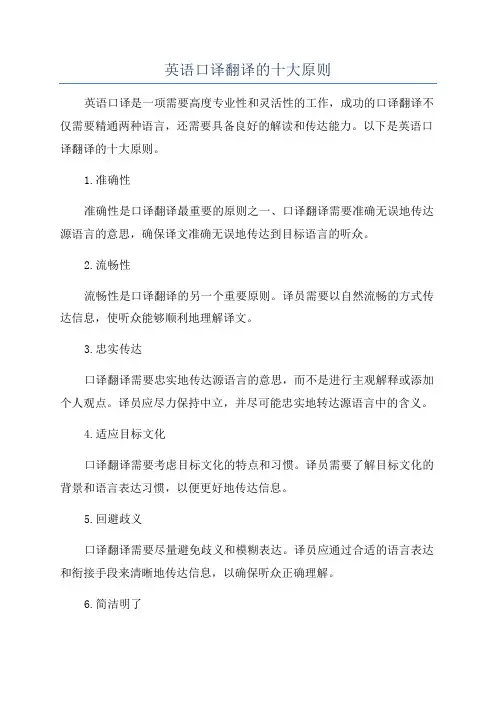
英语口译翻译的十大原则英语口译是一项需要高度专业性和灵活性的工作,成功的口译翻译不仅需要精通两种语言,还需要具备良好的解读和传达能力。
以下是英语口译翻译的十大原则。
1.准确性准确性是口译翻译最重要的原则之一、口译翻译需要准确无误地传达源语言的意思,确保译文准确无误地传达到目标语言的听众。
2.流畅性流畅性是口译翻译的另一个重要原则。
译员需要以自然流畅的方式传达信息,使听众能够顺利地理解译文。
3.忠实传达口译翻译需要忠实地传达源语言的意思,而不是进行主观解释或添加个人观点。
译员应尽力保持中立,并尽可能忠实地转达源语言中的含义。
4.适应目标文化口译翻译需要考虑目标文化的特点和习惯。
译员需要了解目标文化的背景和语言表达习惯,以便更好地传达信息。
5.回避歧义口译翻译需要尽量避免歧义和模糊表达。
译员应通过合适的语言表达和衔接手段来清晰地传达信息,以确保听众正确理解。
6.简洁明了口译翻译需要保持简洁明了,避免过多的修饰和累赘的句子结构。
译员应尽量使用简短明了的语言,以保持听众的专注和理解。
7.时效性口译翻译需要在接收到信息后迅速准确地进行转达。
译员需要具备快速反应和思维敏捷的能力,以便及时地传达信息。
8.语法准确口译翻译需要遵循源语言和目标语言的语法规则。
译员应注意语法结构的正确性,并尽量避免语法错误和不通顺的表达。
9.场景感知口译翻译需要根据不同的场景和语境来进行适当的翻译。
译员应根据具体的场合和需求,选择合适的词汇和表达方式来传达信息。
10.职业道德口译翻译需要遵守职业道德准则,保持译员的中立性和保密性。
译员应尽力避免个人偏见和利益冲突,确保译文的专业性和可信度。
以上是英语口译翻译的十大原则。
通过遵循这些原则,口译翻译能够更好地传达信息并实现沟通的目的。

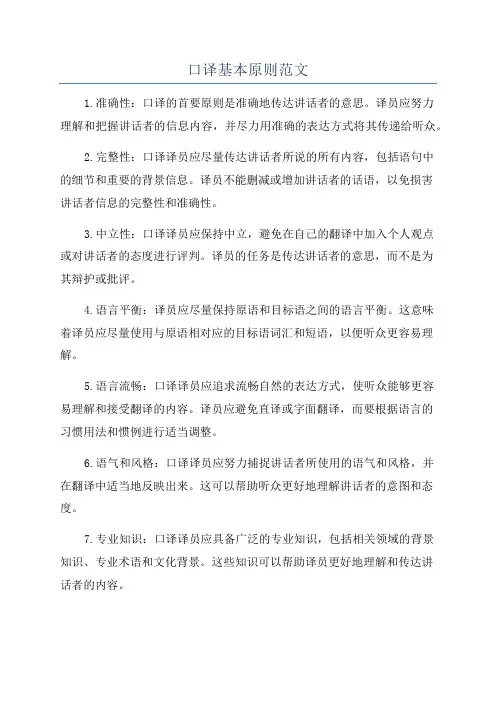
口译基本原则范文
1.准确性:口译的首要原则是准确地传达讲话者的意思。
译员应努力
理解和把握讲话者的信息内容,并尽力用准确的表达方式将其传递给听众。
2.完整性:口译译员应尽量传达讲话者所说的所有内容,包括语句中
的细节和重要的背景信息。
译员不能删减或增加讲话者的话语,以免损害
讲话者信息的完整性和准确性。
3.中立性:口译译员应保持中立,避免在自己的翻译中加入个人观点
或对讲话者的态度进行评判。
译员的任务是传达讲话者的意思,而不是为
其辩护或批评。
4.语言平衡:译员应尽量保持原语和目标语之间的语言平衡。
这意味
着译员应尽量使用与原语相对应的目标语词汇和短语,以便听众更容易理解。
5.语言流畅:口译译员应追求流畅自然的表达方式,使听众能够更容
易理解和接受翻译的内容。
译员应避免直译或字面翻译,而要根据语言的
习惯用法和惯例进行适当调整。
6.语气和风格:口译译员应努力捕捉讲话者所使用的语气和风格,并
在翻译中适当地反映出来。
这可以帮助听众更好地理解讲话者的意图和态度。
7.专业知识:口译译员应具备广泛的专业知识,包括相关领域的背景
知识、专业术语和文化背景。
这些知识可以帮助译员更好地理解和传达讲
话者的内容。
总结起来,口译基本原则包括准确性、完整性、中立性、语言平衡、语言流畅、语气和风格的反映、专业知识和忠实再现。
译员在实践口译活动时,应根据这些原则来进行翻译工作,以确保高质量和准确性。
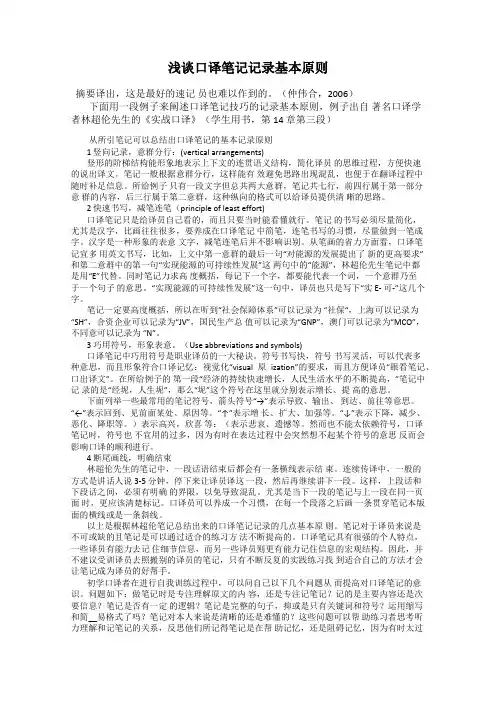
浅谈口译笔记记录基本原则摘要译出,这是最好的速记员也难以作到的。
(仲伟合,2006)下面用一段例子来阐述口译笔记技巧的记录基本原则,例子出自著名口译学者林超伦先生的《实战口译》(学生用书,第14 章第三段)从所引笔记可以总结出口译笔记的基本记录原则1 竖向记录,意群分行:(vertical arrangements)竖形的阶梯结构能形象地表示上下文的连贯语义结构,简化译员的思维过程,方便快速的说出译文。
笔记一般根据意群分行,这样能有效避免思路出现混乱,也便于在翻译过程中随时补足信息。
所给例子只有一段文字但总共两大意群,笔记共七行,前四行属于第一部分意群的内容,后三行属于第二意群,这种纵向的格式可以给译员提供清晰的思路。
2 快速书写,减笔连笔(principle of least effort)口译笔记只是给译员自己看的,而且只要当时能看懂就行。
笔记的书写必须尽量简化,尤其是汉字,比画往往很多,要养成在口译笔记中简笔,连笔书写的习惯,尽量做到一笔成字。
汉字是一种形象的表意文字,减笔连笔后并不影响识别。
从笔画的省力方面看,口译笔记宜多用英文书写,比如,上文中第一意群的最后一句“对能源的发展提出了新的更高要求”和第二意群中的第一句“实现能源的可持续性发展”这两句中的“能源”,林超伦先生笔记中都是用“E”代替。
同时笔记力求高度概括,每记下一个字,都要能代表一个词,一个意群乃至于一个句子的意思。
“实现能源的可持续性发展”这一句中,译员也只是写下“实 E- 可-”这几个字。
笔记一定要高度概括,所以在听到“社会保障体系”可以记录为“社保“,上海可以记录为“SH”,合资企业可以记录为“JV”,国民生产总值可以记录为“GNP”,澳门可以记录为“MCO”,不同意可以记录为“N”。
3 巧用符号,形象表意。
(Use abbreviations and symbols)口译笔记中巧用符号是职业译员的一大秘诀。
符号书写快,符号书写灵活,可以代表多种意思,而且形象符合口译记忆:视觉化“visual原ization”的要求,而且方便译员“眼看笔记、口出译文”。
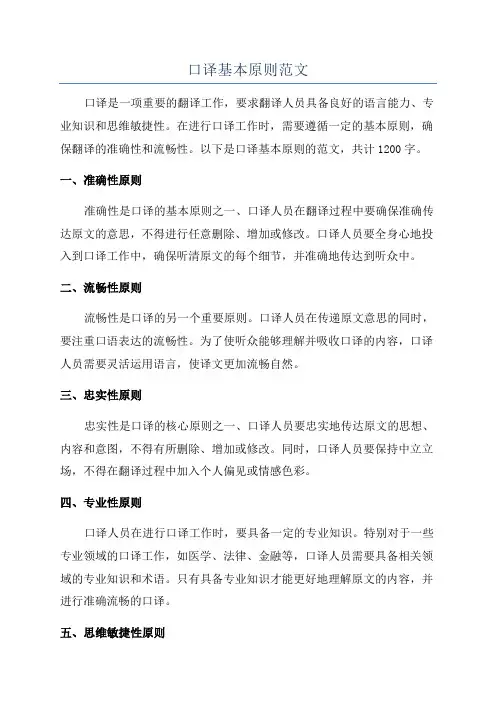
口译基本原则范文口译是一项重要的翻译工作,要求翻译人员具备良好的语言能力、专业知识和思维敏捷性。
在进行口译工作时,需要遵循一定的基本原则,确保翻译的准确性和流畅性。
以下是口译基本原则的范文,共计1200字。
一、准确性原则准确性是口译的基本原则之一、口译人员在翻译过程中要确保准确传达原文的意思,不得进行任意删除、增加或修改。
口译人员要全身心地投入到口译工作中,确保听清原文的每个细节,并准确地传达到听众中。
二、流畅性原则流畅性是口译的另一个重要原则。
口译人员在传递原文意思的同时,要注重口语表达的流畅性。
为了使听众能够理解并吸收口译的内容,口译人员需要灵活运用语言,使译文更加流畅自然。
三、忠实性原则忠实性是口译的核心原则之一、口译人员要忠实地传达原文的思想、内容和意图,不得有所删除、增加或修改。
同时,口译人员要保持中立立场,不得在翻译过程中加入个人偏见或情感色彩。
四、专业性原则口译人员在进行口译工作时,要具备一定的专业知识。
特别对于一些专业领域的口译工作,如医学、法律、金融等,口译人员需要具备相关领域的专业知识和术语。
只有具备专业知识才能更好地理解原文的内容,并进行准确流畅的口译。
五、思维敏捷性原则思维敏捷性是一名优秀口译人员必备的能力之一、在进行口译工作时,口译人员需要快速反应,捕捉到原文的每个细节,并在短时间内进行适当的翻译。
思维敏捷性可以提高口译人员的工作效率和质量。
六、适应性原则适应性是一名优秀口译人员必备的素质之一、口译人员要根据不同的场合、听众和文化背景,灵活调整自己的表达方式和语言风格。
只有适应不同的情境,才能更好地传达原文的意思,并产生理想的口译效果。
七、时效性原则时效性是一项重要的原则,要求口译人员在规定的时间内完成翻译任务。
口译人员需要在短时间内做好准备工作,熟悉原文的内容,并提前预判可能出现的问题。
只有具备时效性,才能保证口译人员在紧迫的时间下,进行高质量的口译工作。
八、保密性原则保密性是一项重要的原则,要求口译人员对译文的内容保密。
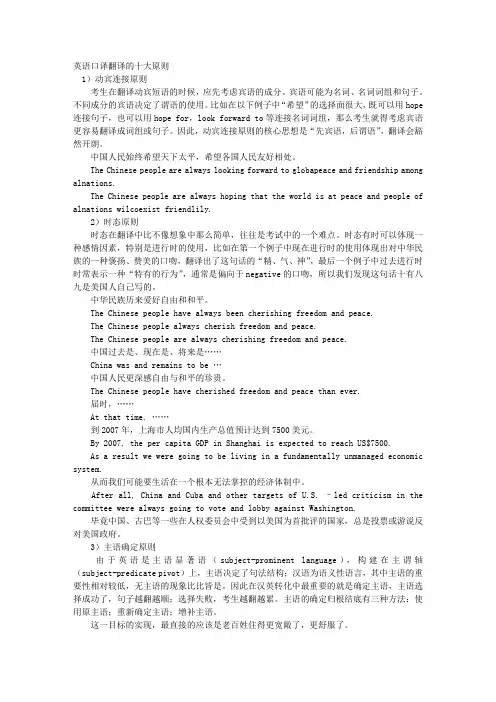
英语口译翻译的十大原则1)动宾连接原则考生在翻译动宾短语的时候,应先考虑宾语的成分。
宾语可能为名词、名词词组和句子。
不同成分的宾语决定了谓语的使用。
比如在以下例子中“希望”的选择面很大,既可以用hope 连接句子,也可以用hope for,look forward to等连接名词词组,那么考生就得考虑宾语更容易翻译成词组或句子。
因此,动宾连接原则的核心思想是“先宾语,后谓语”,翻译会豁然开朗。
中国人民始终希望天下太平,希望各国人民友好相处。
The Chinese people are always looking forward to globapeace and friendship among alnations.The Chinese people are always hoping that the world is at peace and people of alnations wilcoexist friendlily.2)时态原则时态在翻译中比不像想象中那么简单,往往是考试中的一个难点。
时态有时可以体现一种感情因素,特别是进行时的使用,比如在第一个例子中现在进行时的使用体现出对中华民族的一种褒扬、赞美的口吻,翻译出了这句话的“精、气、神”,最后一个例子中过去进行时时常表示一种“特有的行为”,通常是偏向于negative的口吻,所以我们发现这句话十有八九是美国人自己写的。
中华民族历来爱好自由和和平。
The Chinese people have always been cherishing freedom and peace.The Chinese people always cherish freedom and peace.The Chinese people are always cherishing freedom and peace.中国过去是、现在是、将来是……China was and remains to be …中国人民更深感自由与和平的珍贵。
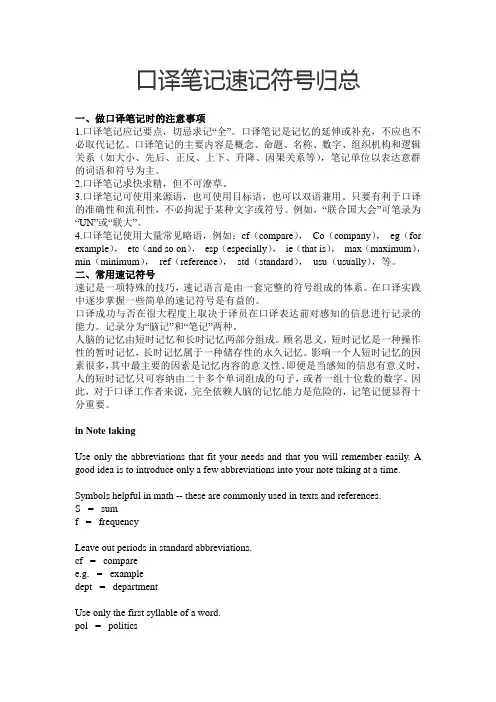
口译笔记速记符号归总一、做口译笔记时的注意事项1.口译笔记应记要点,切忌求记“全”。
口译笔记是记忆的延伸或补充,不应也不必取代记忆。
口译笔记的主要内容是概念、命题、名称、数字、组织机构和逻辑关系(如大小、先后、正反、上下、升降、因果关系等),笔记单位以表达意群的词语和符号为主。
2.口译笔记求快求精,但不可潦草。
3.口译笔记可使用来源语,也可使用目标语,也可以双语兼用。
只要有利于口译的准确性和流利性,不必拘泥于某种文字或符号。
例如,“联合国大会”可笔录为“UN”或“联大”。
4.口译笔记使用大量常见略语,例如:cf(compare),Co(company),eg(for example),etc(and so on),esp(especially),ie(that is),max(maximum),min(minimum),ref(reference),std(standard),usu(usually),等。
二、常用速记符号速记是一项特殊的技巧,速记语言是由一套完整的符号组成的体系。
在口译实践中逐步掌握一些简单的速记符号是有益的。
口译成功与否在很大程度上取决于译员在口译表达前对感知的信息进行记录的能力。
记录分为“脑记”和“笔记”两种。
人脑的记忆由短时记忆和长时记忆两部分组成。
顾名思义,短时记忆是一种操作性的暂时记忆,长时记忆属于一种储存性的永久记忆。
影响一个人短时记忆的因素很多,其中最主要的因素是记忆内容的意义性。
即便是当感知的信息有意义时,人的短时记忆只可容纳由二十多个单词组成的句子,或者一组十位数的数字。
因此,对于口译工作者来说,完全依赖人脑的记忆能力是危险的,记笔记便显得十分重要。
in Note takingUse only the abbreviations that fit your needs and that you will remember easily. A good idea is to introduce only a few abbreviations into your note taking at a time. Symbols helpful in math -- these are commonly used in texts and references.S = sumf = frequencyLeave out periods in standard abbreviations.cf = comparee.g. = exampledept = departmentUse only the first syllable of a word.pol = politicslib = liberalcap = capitalismUse entire first syllable and only 1st letter of 2nd syllable.pres = presentationsubj = subjectind = individualcons = conservativeEliminate final letters. Use just enough of the word to form a recognizable abbreviation.assoc = associatebiol = biologyinfo = informationach = achievementchem = chemistrymax = maximumintro = introductionconc = concentrationmin = minimumrep = repetitionOmit vowels, retain only enough consonants to give a recognizable skeleton of the word.ppd = preparedprblm = problemestmt = estimatebkgd = backgroundgvt = governmentUse an apostrophe in place of letters.am't = amountcont'd = continuedgov't = governmenteducat'l = educationalForm the plural of a symbol or abbreviated word by adding s.chpts = chaptersegs = examplesfs = frequenciesintros = introductionsUse g to represent ing endings.estg = establishingdecrg = decreasingexptg = experimentingSpell out short words such as in, at, to, but, for, and key.Abbreviations or symbols for short words will make the notes too dense with shorthand.Leave out unimportant words.Leave out the words a and the.If a term, phrase, or name is written out in full during the lecture, substitute initials whenever the term, phrase, or name is used again. For example, Center for Aerospace Sciences becomes CAS thereafter.Use symbols for commonly recurring connective or transitional words.& = andw/ = withw/o = withoutvs = against\ = therefore= = is or equalUse technical symbols where applicable.zb = German, for exampleibid = Latin, the same worko = degreesH2O = waterMore reference:Use standard maths, accounting, and science symbols. Examples:+ plus// parallelUse standard abbreviations and leave out full stops. Examples:eg exampleIT dept Information Technology departmentUK United KingdomUse only the first syllable of a word. Examples:mar marketingcus customercli clientUse the entire first syllable and the first letter of the second syllable. Examples:subj subjectbudg budgetind individualTo distinguish among various forms of the same word, use the first syllable of the word, an apostrophe, and the ending of the word. Examples:tech'gy technologygen'ion generalisationdel'y deliveryUse just enough of the beginning of a word to form a recognisable abbreviation. Examples:assoc associatedach achievementinfo informationOmit vowels from the middle of words, retaining only enough consonants to provide a recognisable skeleton of the word. Examples:bkgd backgroundmvmt movementprblm problemForm the plural of a symbol or abbreviated word by adding 's.' Examples:custs customersfs frequencies/s ratiosUse 'g' to represent 'ing' endings. Examples:decrg decreasingckg checkingestblg establishingSpell out, rather than abbreviate short words. Examples:inbutaskeyLeave out unimportant verbs. Examples:iswaswereLeave out unnecessary articles. Examples:aantheIf a term, phrase, or name is initially written out in full during the talk or meeting, initials can be substituted whenever the term, phrase, or name is used again. Example: January Advertising Campaign Budget JACBUse symbols for common connective or transition words. Examples:@ at2 to4 for& andw/ withw/o withoutvs againstCreate your own set of abbreviations and symbols. You may wish to develop separate sets of symbols and abbreviations for different courses or subjects.Other Symbols and Abbreviationsas a result of / consequences of <--->resulting in --->and / also +equal to / same as =following ffmost importantly *less than <greater than > especially esp/一、缩略词英语当中缩略词使用的频率很高,如IMP: important, ASAP: as soon as possible。
口译入门笔记法口译笔记法是口译员在进行口译时常用的一种辅助记忆和理解的方法。
以下是一些口译入门笔记法的基本原则和技巧:1. 简洁明了:笔记应该简洁明了,不要写下完整的句子,而是写下关键词、短语或缩写,以便快速回忆和理解。
2. 符号和缩写:使用符号和缩写可以帮助你更快地记录信息。
例如,用“&”表示“和”,用“+”表示“加”,用“=”表示“等于”等。
3. 分区记录:将笔记分为不同的区域,例如左侧记录发言人的讲话内容,右侧记录自己的翻译或理解。
4. 纵向记录:将笔记按照纵向排列,这样可以更清晰地看到信息之间的逻辑关系。
5. 重点突出:在笔记中突出重点信息,例如使用下划线、加粗或不同颜色的笔来标注重要的词汇或短语。
6. 练习记忆:在记录笔记的同时,也要尽量练习记忆,以便在没有笔记的情况下也能进行口译。
需要注意的是,口译笔记法只是一种辅助记忆和理解的方法,不能完全依赖笔记。
在进行口译时,还需要依靠自己的语言能力、听力理解和反应速度等方面的素质。
当然可以,以下是一些具体的口译笔记示例:1. 符号和缩写:- 使用符号“/”表示“或者”,例如“China/US”表示“中国或美国”。
- 使用缩写“WTO”表示“世界贸易组织”,“GDP”表示“国内生产总值”。
2. 分区记录:- 将笔记分为左右两个区域,左侧记录发言人的讲话内容,右侧记录自己的翻译或理解。
- 在左侧区域中,可以使用纵向排列的方式记录信息,例如“经济发展/环境保护”。
- 在右侧区域中,可以写下自己的翻译“Economic development/Environmental protection”。
3. 重点突出:- 使用下划线、加粗或不同颜色的笔来标注重要的词汇或短语,例如“全球化”、“可持续发展”等。
- 可以使用箭头或其他符号来表示信息之间的逻辑关系,例如“因为-所以”、“虽然-但是”等。
需要注意的是,口译笔记法是一种辅助记忆和理解的方法,不能完全依赖笔记。
口译时应注意的基本原则
1、严格遵守原文表达的实质性和准确性。
翻译口译过程中,原文中包含的实质性内容应当尽可能准确地传达出来,而非表面意思。
2、准确把握文章的核心内容、在总体框架下将文章的全部信息准确表达出来。
3、尊重原文的文化背景,考虑语言礼仪,重视翻译时的文字辞令的文化性。
4、理解原文的前景,以及文中出现的人物、事件、历史知识、地理等,确保翻译过程中文字信息的准确性和合理性。
5、在翻译中,应尽可能准确而又口译地表达出多种原文中出现的不同色彩、美感、表情和情感,避免枯燥乏味。
6、尽可能采用简练、明快的表达方式,清晰地传达出原文的内容,提高翻译效率。
7、尽可能多地使用语言,做到不断宣扬、不断更新,充分利用口语中的形式,以及增加形容词和副词,使口译更加生动。
8、尽可能使用当代的语言,以便使受众能够迅速掌握信息,从而在口译过程中妥善处理概念、思想和观点。
9、尊重受众的文化背景知识,更加贴近受众,确保口译传达信息的准确性。
10、注意保持口语流利性,避免重复及难思易解的表述。
翻译宗旨:忠实,通顺翻译核心原则:思维居中--捕捉居中的关键词组|意识跟随--对对话的关键信息进行超前的逻辑延伸|首出原则--理解大略的文意,运用最熟悉的语块组合|意念整合--对全文的大概逻辑编排进行整合翻译操作原则:(翻译实战中的关键)吸要义--快速抓住句子含义|去结构--吸取要点信息,去除原来语言的句型结构|换思维--听中文用英文,听英文套正文,用终端语言判断译文的措辞和结构|用习惯--符合中文/英文惯用的表达方式翻译方法:1.语序---顺/逆(主语和谓语作为顺序的判断依据,与原文一致为顺,以此类推)2.词组---增/减,省/替,转/搭(中英表达习惯之间的差异造成的增减)3.语态--被/主(中英文语法中的要求,一般英文被动,中文主动,反之亦然)4. 句子--合/切(中英文中长短句,从句的处理)符号原则:1.中文(母语)优先2.快速便捷记录(中文复杂用英语,英文复杂用中文)3.数字必记听记原则:1.心放松2.神要宁(宁心听要义,凝心记重点)3.手要快4.意要串(要义串成一体,串成全文)5.绝对信任(对自己能力,翻译技巧的信任)定序原则:居中找定点,以此调词序。
定好核心词(要义)然后进行快速排序。
记忆使用原则:短时记忆--一般为为居中的要义(不记就会忘记的那种)|长时记忆--平时积累的语块,句型|瞬间记忆--头尾瞬间的记忆(不用记也不会忘)PS:显现出来的--短时记忆绝对信任的--瞬时记忆放心使用的--长时记忆记忆不当:会出现语塞(卡住,说不下去),话空(不能及时反应出下文的串联)的情况记忆得当:语言流利且通顺口译原则:1.语气坚定,不抢风头2.明确了解自己是发挥语言媒介给语言增色的作用的角色3.不要过度加习惯语气词以及过度修正原意4.心态放松,放平5.练习时,口译的内容自己明白后才能说出来6.篇章翻译时,越到后面越要稳住,越要提高精神集中力7.信任自己的翻译。
口译时应注意的基本原则口译是一门需要高超翻译技巧和良好语言表达能力的技能。
在进行口译时,有一些基本原则需要注意,以确保信息的准确传达和有效沟通。
以下是口译时应注意的基本原则。
1.准确性:口译的首要原则是准确传达讲话者的意思。
翻译应该始终致力于传达准确的信息,包括理解和转述函数、含义、观点和感情。
翻译时应尽量去除自己的主观色彩,将讲话者的意思忠实转达。
2.完整性:翻译应该尽量保持原文的完整性。
不应该省略或添加任何讲话者的表达,以确保传达准确的信息。
任何遗漏或添加可能会导致信息的不准确传达或误解。
3.自然流畅:翻译应该以自然、流畅的方式进行,以便听众能够轻松地理解和接受。
口译中应尽量使用符合当地习惯的表达方式,并注意语法正确和流畅的语言交流。
4.中立性:翻译应该保持中立和客观。
翻译者应该将讲话者的意思准确传达,而不是加入自己的评价或偏见。
翻译者应努力避免个人喜好或政治倾向的影响,以确保信息的中立传达。
5.时效性:口译需要及时完成,以确保信息的准确传达。
翻译者应尽量在讲话者完成讲话后立即开始翻译工作,以确保信息的实时性和时效性。
及时完成的口译能够更好地满足听众的需求。
6.灵活性:口译需要灵活应对各种场景和需求。
翻译者应具备良好的适应能力,能够迅速调整翻译策略和技巧以适应不同的讲话者、主题和语境。
灵活性可以提高翻译的准确性和效率。
7.语言能力:翻译者应具备广泛的语言知识和能力。
口译需要翻译者具备听、说、读、写四项语言技能,以便准确理解讲话者的意思并有效的进行翻译。
翻译者应不断提高语言能力,保持与时俱进。
8.行业知识:翻译者应具备一定的行业知识,特别是对于特定领域的专业术语和背景知识。
了解讲话者所在领域的相关信息,可以帮助翻译者更好地理解讲话者的意思,并准确地传达信息。
9.注意力和记忆力:口译需要翻译者具备良好的注意力和记忆能力。
翻译者需要专注于讲话者的表达,并能够准确记忆和转述长段落的内容。
保持良好的注意力和记忆力可以提高翻译的质量和效率。
口译时应注意的基本原则口译是传达和转述两种语言之间意思的过程。
作为一名口译员,应该遵循以下基本原则,以确保传达准确和流畅的信息。
1.精确性:口译员首要的责任是准确传达讲话者的意思。
口译员应听得清楚、理解并转述正确的信息,不应该添加、删除或改变原意。
为了确保准确性,口译员应尽量避免在翻译过程中加入个人观点或评价。
2.中立性:口译员应保持中立,不偏袒任何一方。
口译员应尽力维持原讲话者的语气、态度和表达方式。
无论讲话者的观点是否与自己的观点相符,口译员都应努力传达并保持原讲话者的立场和意图。
3.完整性:口译员应尽量翻译完整的信息。
口译员不应该删除或省略任何重要的信息,而应确保将原意完整地传达给听众。
如果原文中有犹豫或语法错误,口译员可以稍微修改语言结构,但不应改变原意。
4.流畅性:口译员应在口译过程中尽力保持流畅的表达。
口译员应熟悉两种语言的文化、习惯用语和俚语,以便在翻译过程中更流畅地转述信息。
口译员应注意语速和节奏,以确保听众能够听懂和理解翻译的内容。
5.适应性:口译员应根据不同的场合和听众的需求进行适应。
在国际会议或学术讲座等正式场合,口译员应采用更正式、专业的语言风格。
在商务会议或谈判等商业场合,口译员应了解并使用相关的商务术语。
适应不同的场合和听众,可以提高口译的有效性和效果。
6.知识和准备:口译员应准备充分并具备相关的知识和背景。
在接受口译任务之前,口译员应了解到会议、演讲或事件的背景资料,包括参与者、议题、相关术语等。
这样可以帮助口译员更好地理解和准确翻译相关内容,并能更好地应对意外情况,如技术术语或特定行业的术语。
7.专业道德:口译员应严格遵守口译的专业道德准则。
口译员应保持保密性,并不泄漏或揭露与工作相关的信息。
另外,口译员应尊重各方的权益,不干扰或干涉讲话者的演讲权利。
总之,作为一名口译员,应该遵循精确性、中立性、完整性、流畅性、适应性、知识和准备以及专业道德等基本原则,以提供高质量和有效的口译服务。
口译的原则
口译是指将一种语言口头表达的信息,转换成另一种语言口头表达的过程。
下面将会介绍口译的原则。
1. 准确性原则:口译员在进行口译时,应尽可能准确地表达原意,并不随意地增减、改变信息。
因此,口译员必须对两种语言都有深刻的理解和掌握,确保信息的翻译准确无误。
2. 忠实原则:口译员应该忠实于原文的意思和情感,不应该在翻译过程中加入自己的个人观点或情感。
同时,口译员应注意文化背景的差异,对原文的文化内涵进行准确翻译。
3. 流畅原则:口译员应保持翻译过程的流畅,能够将信息连贯地传递给听众,而不会在中途产生停顿或迟疑。
这个原则要求口译员的口语表达能力和语言素养都非常高。
4. 速度原则:口译员应该根据演讲者的讲话速度来适度调整自己的翻译速度,不能让听众感到过于匆忙或过于慢悠悠。
快速的翻译会让听众感到紧张,缓慢的翻译则会让听众感到厌烦。
5. 沟通原则:口译员应该保持良好的沟通,与演讲者保持良好的互动,了解他
们的讲话内容和意图。
同时,口译员也需要与听众保持良好的互动,确保他们理解口译的内容。
以上就是口译的原则。
通过遵守这些原则,口译员可以更好地将原文信息准确、忠实地传递给听众。
THE SEVEN PRINCIPLESThe use of a technique is always dependent upon the application of a certain number of principles. This is what we call the instructions. One need not follow the rules recommended in such instructions. Indeed the product, device or system for which they were devised may well work even if they are not observed, but will do so less efficiently. Furthermore, the simpler the instructions, the more likely the user is to follow them. The same applies to note-taking. A few very simple principles give this system its sound base and precision, and make using it straightforward. There are seven of these principles; in order they are:1 Noting the idea and not the word2 The rules of abbreviation3 Links4 Negation5 Adding emphasis6 Verticality7 ShiftSome of these principles have already been explained by Jean Herbert in his Interpreter’s Handbook1.1. Noting the idea rather than the wordTake any French text and give it to 10 excellent english translators. The result will be ten very well translated texts, but ten very different texts in as far as the actual words used are concerned. The fact that we have ten good translations, but ten different texts, shows that what is important is the translation of the idea and not the word. This is even truer of interpretation since the interpreter must produce a version of the text in another language immediately. He must be free of the often misleading constraints that words represent. It is through the analysis and notation of the ideas that the interpreter will avoid mistakes and a laboured delivery.Example: Let us take the following, from French into English: …Il y a des fortes chances pour que...../ There is a very good chance that...” If we base our notation of this expression on the words, the key word is chance. If we base it on the idea, it is probable.The notes will have to be read 20 minutes – even an hour2– after the idea was originally expressed. In the first example it would be very easy to make a mistake. Having noted chance the i nterpreter might, if the context allowed, render it …there is a chance that” or …by chance”. If on the other hand he noted probable the mistake cannot be made. The issue of style is also dealt with in the second example where one would automatically say (interpreting into English), …It is probable that”, or …it is likely that”, or …in all likelihood” whereas in the first example even if the interpreter had correctly recalled the idea that the word chance represented he/she will be a prisoner to that word and might easily produce a gallicism3.1 Georg & C ie, Geneva, 1956.2 this was indeed the case when Rozan wrote. Although nowadays 20 minutes is considered a long consecutive speech, his comments still apply.3 being unduly influenced by the source language is, of course, not only a problem in French-English interpretation but in all interpretation.Example: …We should try to live up to....”. It would be absurd to note the word …live” and it would greatly increase the risk of making a mistake. Although it would seem to be very different from the original it woul d be more appropriate to note in French, for example, … à la hauteur” (in english ‘to be up to’). This is the result of analysing the idea behind what is said and noting it idiomatically in the target language. It would be just as useful to note be =, representing being equal to , which could very easily be read back idiomatically in intepretation (ie. …à la hauteur in French”, …to be up to in English”).Whenever taking notes the interpreter must concentrate on the major idea and how this can be noted clearly and simply (preferably in the target language, although this is not essential).In the practical exercises in Part 3 of this book you will find a number of examples of noting the idea rather than the word. It is recommended that you examine these with particular care.2. The Rules of AbbreviationA. ABBREVIATION OF WORDSThe rule of thumb is that unless a word is short (4-5 letters) the interpreter should note it in an abbreviated form.If we have to note …specialized” it is more meaningful a nd reliable to note sp ed than to write spec.Other examples:Stat.could be read as …statute” or …statistics” whilst St ute and St ics are unambiguous.Prod.could be read as …production”, …producer”, …product” or …productivity” whilePr on, Pr er, Pr ct, Pr vity are unambiguous.Com.could be read as …Commission” or …committee” while C on and C tee are unambiguous.Rule: If you have time write a word as completely as possible, however, if a word must be abbreviated, then write some of the first and last letters rather than trying to write as many letters as possible from the start onwards.B. INDICATING GENDER AND TENSEHaving abbreviated a word or an idea (be it by the use of a symbol or a contraction of its component letters) it can also be very helpful to give an indication of gender4 and tense).Thus in the expression: …I will come back to this a little later”, noting the future tense will render the words …a little later”superfluous. We will see below that …I speak” can be noted : I ”. Therefore we note : I ll”The expression: …those mentioned”, must be noted : rf d; because rf alone could be read back as …those which mention”.4 Rozan was working from and into French. Gender is meaningless for those noting in English, however, the idea could be usefully adapted for use in, for example, the Slavic languages where nouns have gender.Rule: To indicate gender5 and number we add e or s to the symbol or abbreviation. To indicate tense we add ll for the future and d for the past.See also the examples in Part 3.C. ABBREVIATING THE REGISTERThe expression …which have contributed to” is long. The word help is short. Wherever possible we must abbreviate by using a word which conveys the same meaning but is shorter.Similarly, …...which are worth looking at” can be noted int g (interesting).…In order to arrive at some conclusions” can be noted to end.…Taking into account the situation at the present time” can be noted as sit on now.Examine closely the abbreviations in Part 3.3. LinksThe part of any speech that is both the most important and the most difficult to note is the sequence of ideas and the links between them. (Jean Herbert)An idea can be distorted completely if its relation to the previous idea is not clearly indicated. When taking notes then, we should never miss out the links. Indeed what we actually see is that if the links are noted well the rest of the idea can be summarised in just a few strokes of the pen.A. Noting links becomes very simple if we use the key words that follow. (Over time this will become automatic.)as, why and that is because, this is the reason why, since, given the fact that, (in some instances) given that; to convey explanation.tho although, despite the fact that; to convey oppositionbut on the other hand, but, nevertheless, however; to convey limitationsif it is possible that, assuming that; to convey supposition.as to as far as x is concerned, on the matter of; to convey referencetfe therefore, one can then conclude; to convey conclusion.The three symbols below (which can also be found in Part 2) are also extremely useful. =the same goes for, one might say the same of; to convey the idea ofequality or correspondanceon the other hand, contrary to; to convey the idea of difference or lackof correspondancein + in addition, furthermore, if we also take account of; to convey the ideaof additional precision.5Again the ‘e’ represents the French feminine ending. Any letter can be used and this will depend on the languages involved.B. Linking is not just about representing the idea; it will often impacton the very content of the speech. It is a question of notingquickly and without repetition the group of subject words and thegroup of complement words to which the idea relates. This problemcan be solved quickly and easily by using the the recall arrow (JeanHerbert)Examine carefully the examples of links in Part 3.4. and5. Negation and emphasisNegation and emphasis are two essential elements of any speech and as such should be noted unambiguously (See Jean Herbert pp46-47).1. NEGATIONNegation might be noted by means of a line running through a word or symbol. Example:If we use OK to signify …agree”, then …disagree” will be OK . It is also possible to write the word no before the word to be negated (thus in our example we would note no OK). This second method is clearer and since …no” is a very short word using it is not a problem.2. EMPHASISTo emphasize a word we can underline it (twice if we are dealing with a superlative or absolute).Example:…(The study) is interesting” : int g…(The study) is very interesting” : int g…(The study) is extremely interesting” : int gIn some cases the line may be replaced by a circumflex to avoid confusion arising from the use of verticality.Alternatively emphasis can be noted with a dotted line.Example:…This report might be useful” : usefulThe use of underlining to denote nuance allows us to qualify the word (or idea) underlined without noting the qualifier.Example:…important question” becomes : ?…we should look at this very carefully” becomes : look at…I would like to say in the strongest possible terms” becomes : I say…...an imperfect solution” becomes : sol tn6. VERTICALITYIt is the principles of Verticality and Shift (described in the next section) which form the backbone of the note-taking system described in this book.Verticality means taking notes from top to bottom rather than from left to right. This method makes it possible to:a) group ideas logically, allowing a complete and immediate synthesis when we come to read back our notes,b) to do away with many links which would otherwise be essential to the clarity of the text.A. STACKING…Stacking6” consists of placing different elements of the text above or below one another.…the report on western europe”R ort .W Eur.…the report on western europe is an interesting document”R ort int gW Eur.…Since the French, US and UK delegations....”…Since the French, US and UK delegations have suggested....”FreAs USUKFreAs US suggest dUK…T he chapters of the report which deal with economic situation in Europe offer additional information and new statistics”Ch rs info_________ give newEc.Eur stat ics6…Superposition” in FrenchIf (as we will see in part 2) the sign → is used to denote …offer” and the sign + to denote …additional” and …new” then our notes will look like this:Ch rs info_________ → +Ec.Eur stat icsSee the examples in the practical exercises in part 3 and study them carefully.B. USING BRACKETSBrackets are an important part of the verticality system. In every speech there will be certain elements, which are mentioned to clarify an idea or to highlight a particular point, but which are not integral to the speaker’s train of thought.These parts of a speech should be noted in brackets, below the main element to which they refer.Examples:…....which leads to new investment, particularly in the transport sector”→ + inv ts(T ort)…(We hear that our exports will suffer as a result of increases in factor costs), which will make them less competitive.”(so - comp ive)See also the examples of the use of parentheses given in the practical exercises at the back.To encourage a natural use of the verticality technique it is recommended that you use relatively large but narrow pieces of paper. This will allow you to note the maximum amount of text on one page whilst automatically bringing your notes back to the left hand side of the page.7. SHIFTShift and Verticality are the fundamental principles underlying this note-taking system.To explain Shift let us take an example: …Over the course of 1954, prices rose, although not to the same extent as income, thus the population’s net income increased.” Our notes will be as follows ( the symbol ⌦ denotes increase):54, prices ⌦but ───── no = ⌦ incomeso ────Pop on⌦Word for word on the first line : Over the course of 1954, prices rose,Word for word on the second line : although not to the same extent as income,Word for word on the third line : thus the population’s net income increased.Having used Shift to give our notes a vertical layout on the page, noting the links is almost enough to give us an accurate and full version of the text.Shift means writing notes in the place on a lower line where they would have appeared had the text on the line above been repeated.The examples below show how notes would be positioned during interpretation, but have not been abbreviated.…The report on the economic situation in Europe is a fine document which discusses some interesting topics”:R ort goodEc.Eurdiscusses interesting topics…to understand the program, one must”to understand the programone must…The effectiveness of the Social and Economic Council’s efforts at solving.....”effectiveness efforts Ecosocat solving.....…Thus in the Report and the Study we find a theoretical and practical analysis which will help in the adoption of......”tfe(in R ort)Studytheoreticalthere is analysis practicalwhich will help in the adoption of See also examples of Shift in part 3.。